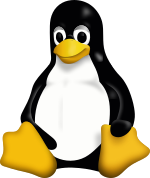Linux
Linux sī 1-chióng chū-iû ê chok-gia̍p hē-thóng. Linux chit-ê bêng-sû si̍t-chāi sī chí Linux kernel ê pō͘-hūn, chóng--sī chhiâng-chāi hō͘ lâng iōng lâi piáu-sī pau-koah kernel chāi-lāi ê kui-thò Unix-khoán (Unix-like) ê chok-gia̍p hē-thóng, hō͘-chò GNU/Linux. GNU ê pō͘-hūn chí GNU sū-kang thê-kiong ê chi̍p (library) kap ke-si-thâu-á.
 | |
| Developer |
Community contributors Linus Torvalds |
|---|---|
| Written in | C, assembly languages, and others |
| OS family | Unix-like |
| Working state | Current |
| Source model | Open source |
| Initial release | 1991 nî 9 goe̍h 17 ji̍t |
| Repository |
git |
| Marketing target | Cloud computing, embedded devices, mainframe computers, mobile devices, personal computers, servers, supercomputers |
| Available in | Multilingual |
| Platforms | Alpha, ARC, ARM, C6x, C-Sky, H8/300, Hexagon, IA-64, m68k, Microblaze, MIPS, Nios II, OpenRISC, PA-RISC, PowerPC, RISC-V, s390, SuperH, SPARC, x86, Xtensa |
| Kernel type | Monolithic |
| Userland | GNU[lower-alpha 1], BusyBox[lower-alpha 2] |
| Default user interface |
|
| License | GPLv2[9] and others (the name "Linux" is a trademark[lower-alpha 3]) |
| Official website |
kernel |
| Articles in the series | |
|
Linux kernel Linux distribution | |
Tsù-sik
siu-kái- ↑ GNU is the primary userland used in nearly all Linux distributions.[2][3][4] The GNU userland contains system daemons, user applications, the GUI, and various libraries. GNU Core utilities are an essential part of most distributions. Most Linux distributions use the X Window system.[5] Other components of the userland, such as the widget toolkit, vary with the specific distribution, desktop environment, and user configuration.[6]
- ↑ BusyBox is an alternative userland used in many embedded Linux distributions. BusyBox replaces most GNU Core utilities.[7] One notable Desktop distribution using BusyBox is Alpine Linux[8]
- ↑ "Linux" trademark is owned by Linus Torvalds[10] and administered by the Linux Mark Institute.
Tsù-kái
siu-kái- ↑ Linux Online (2008). "Linux Logos and Mascots". goân-loē-iông tī August 15, 2010 hőng khó͘-pih. August 11, 2009 khòaⁿ--ê.
- ↑ "GNU Userland". goân-loē-iông tī March 8, 2016 hőng khó͘-pih.
- ↑ "Unix Fundamentals — System Administration for Cyborgs". goân-loē-iông tī October 5, 2016 hőng khó͘-pih.
- ↑ "Operating Systems — Introduction to Information and Communication Technology". goân-loē-iông tī February 21, 2016 hőng khó͘-pih.
- ↑ "The X Window System". goân-loē-iông tī January 20, 2016 hőng khó͘-pih.
- ↑ "PCLinuxOS Magazine - HTML". goân-loē-iông tī May 15, 2013 hőng khó͘-pih.
- ↑ "The Busybox about page". busybox.net.
- ↑ "The Alpine Linux about page". alpinelinux.org.
- ↑ "The Linux Kernel Archives: Frequently asked questions". kernel.org. September 2, 2014. goân-loē-iông tī September 5, 2015 hőng khó͘-pih. September 4, 2015 khòaⁿ--ê.
- ↑ "U.S. Reg No: 1916230". United States Patent and Trademark Office. goân-loē-iông tī June 24, 2013 hőng khó͘-pih. April 1, 2006 khòaⁿ--ê.
Tsham-ua̍t
siu-kái- Bangkok kui-chek (Bangkok kui-tsik; eng-gí: Bangkok Rules)
- Antonov An-2
- Bí-kok kok-ka kì-liām-khu (National monument (United States))
- Chio̍h-eng (Tsio̍h-ing/Quartz)
- Kham-ko (Crucible/坩堝/iûñ-khòng-lôo)
Guā-pōo lên-ket
siu-kái- Linux teh DMOZ
- Graphical map of Linux Internals
- Linux kernel website and archives
- The History of Linux in GIT Repository Format 1992–2010
| Pún bûn-chiuⁿ sī chi̍t phiⁿ phí-á-kiáⁿ. Lí thang tàu khok-chhiong lâi pang-chō͘ Wikipedia. |